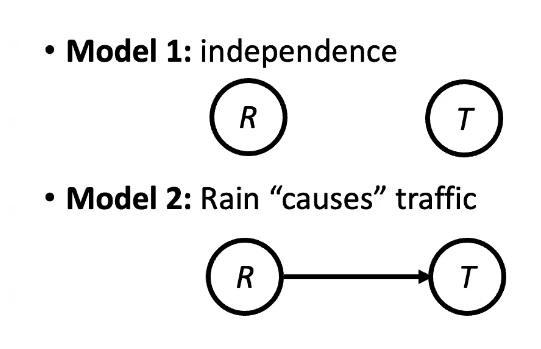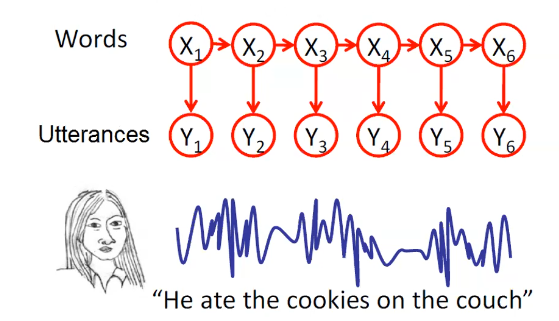Probabilistic Models §
- Models describe hos (a portion oif) the world works
- Models are always simplifications
- They may not account for every variable
- May not account for all interactions between variables
- “All models are wrong; but some are useful” - George E P Box
- What do we do with probabilistic models?
- We (or our agents) need to reason about unknown variables, given evidence
- Example: explanation (diagnostic reasoning)
- Example: prediction (causal reasoning)
- Example: value of information
Bayesian Networks §
- Two problems with using full joint distribution tables:
- Unless there are only a few variables, the joint distirbution is WAY too big to represent explicitly
- Hard to learn empirically about more than a few variables at a time
- Bayesian networks: a technique for describing complex joint distributions (models) using simple, local distributions (conditional probabilities)
- A special case of graphical modles
- Describe how variables locallyi interadct
- Local intercations chain together to give global indirect actions
Graphical Model Notation §
- Nodes: random variables (with domains)
- Can be assigned (observed) or unassigned (unobserved)
- Edges: interactions
- Indicate “direct influence” between variables
- Formally: encode conditional independence
- Imagine that arrows mean “direct causation” (in general they do not, but this is a convenient assumption for now!)
- Example: N independent coin flips

- No interactions between variables: absolute independence
- Example: Traffic
- Variables
- R: It rains; T: there is traffic
- Model 1: indpendence
- Model 2: Rain “causes” traffic

Real world Application: Speech recognition §
- Infer spoken words from audio signals
- Markov Assumption: the future and past are indpendent given the present
- Hidden variable Xi (words)
- Observed variable Yj (waveform)
- Goal: Infer P(Xi∣Y1,…,Yn)∀i

Bayesian Network (BN) Semantics §
- A set of notdes, one per random variable X
- A directed, acyclic graph
- A conditional distribution for each node
- A collection of probability distributions over X, one for each combination of parents’ values
- P(X∣a1,…,an)
- CPT: conditional probability table
- Description of a noisy “causal” process
Probabilities in BNs §
- Bayes’ nets implicitly encode the joint distribution as a product of local conditional distributions:
- P(x1,x2,…xn)=i=1∏nP(xi∣parents(Xi))
- To see what probability a BN gives to a full assignment, multiply all the relevant conditionals together
- Why are we guaranteed that BN results in a proper joint distribution?
- Chain rule (valid for all distributions): P(x1,x2…xn)=i=1∏nP(xi∣x1…xi−1)
- Combining this with an assumption of conditional indpendence makes a proper joint distribution
- A BN cannot represent all possible joint distributions
- The topology enforces certain conditional indepdnencies


